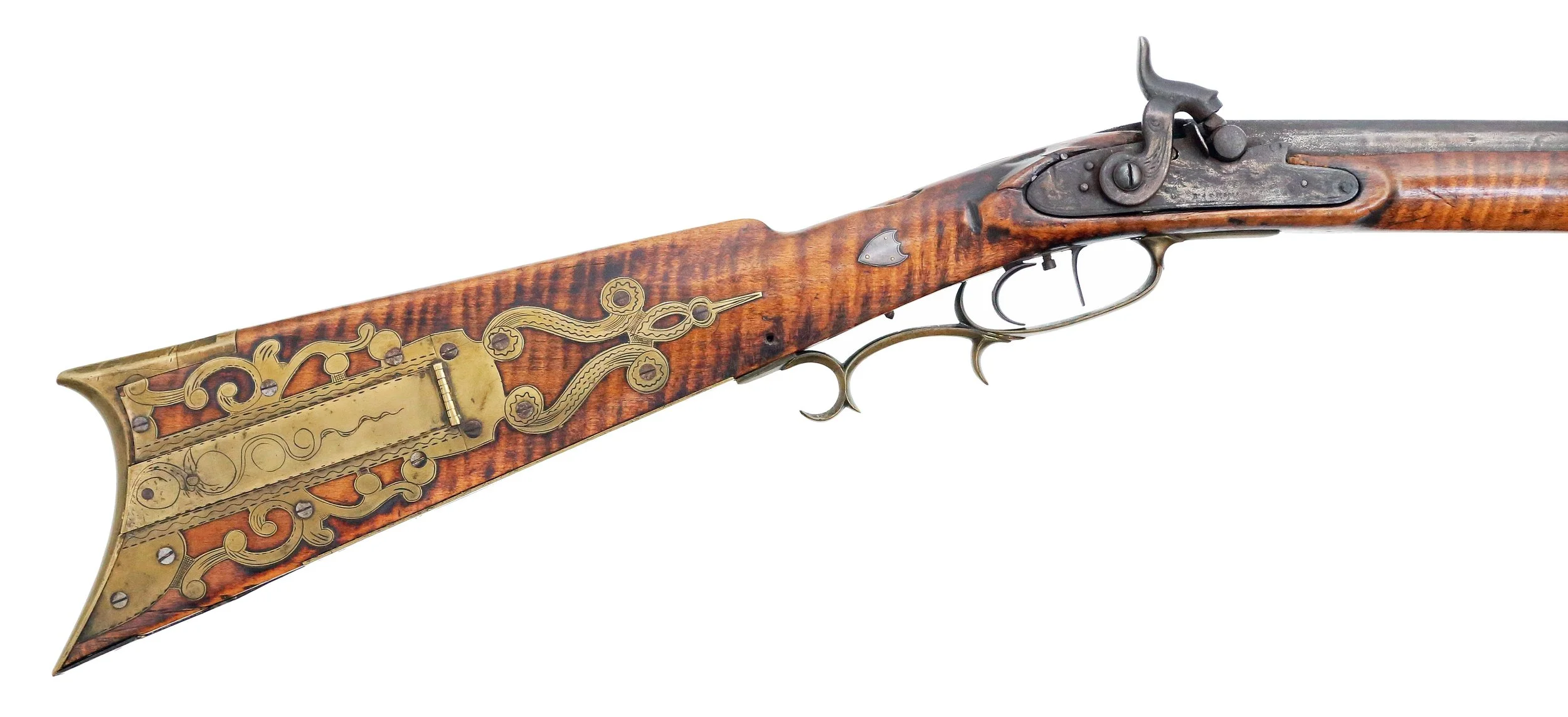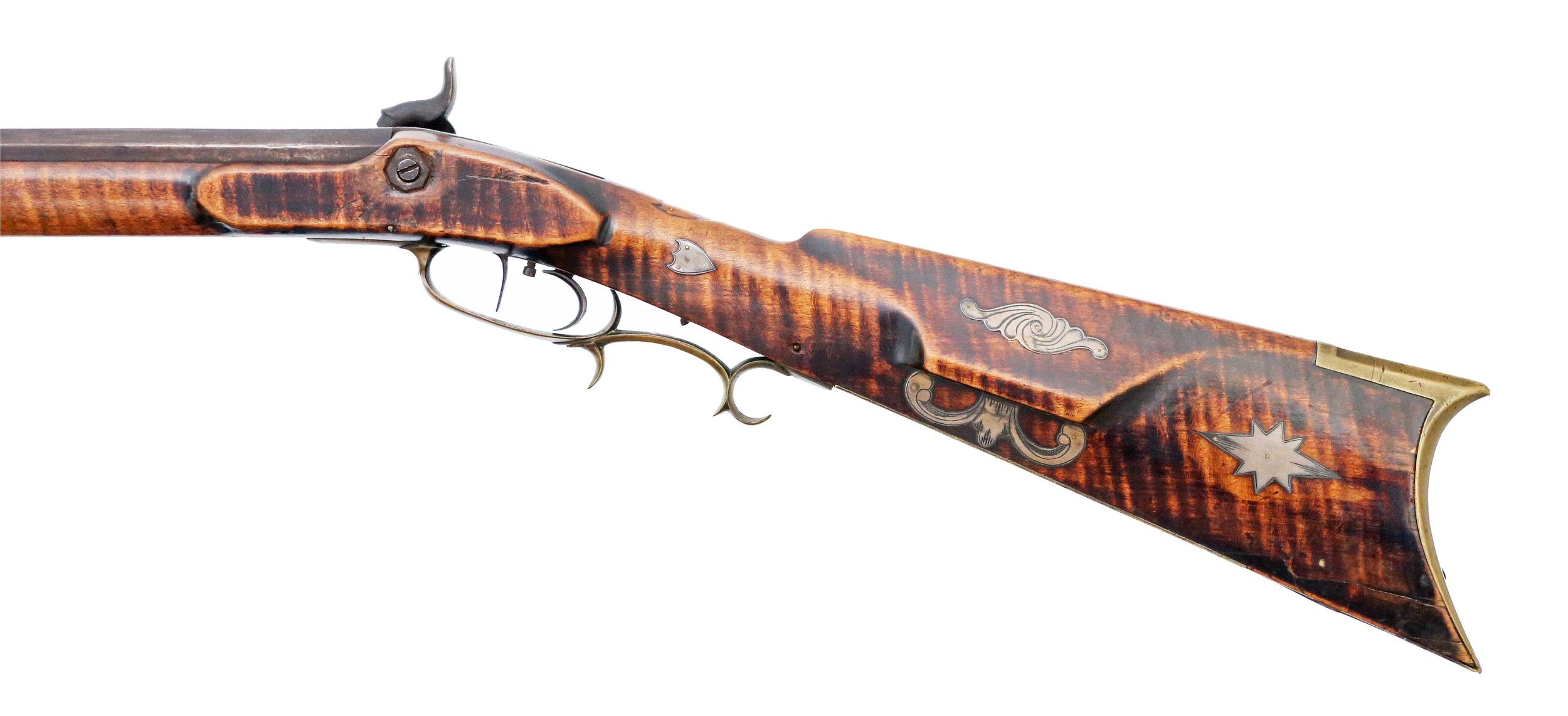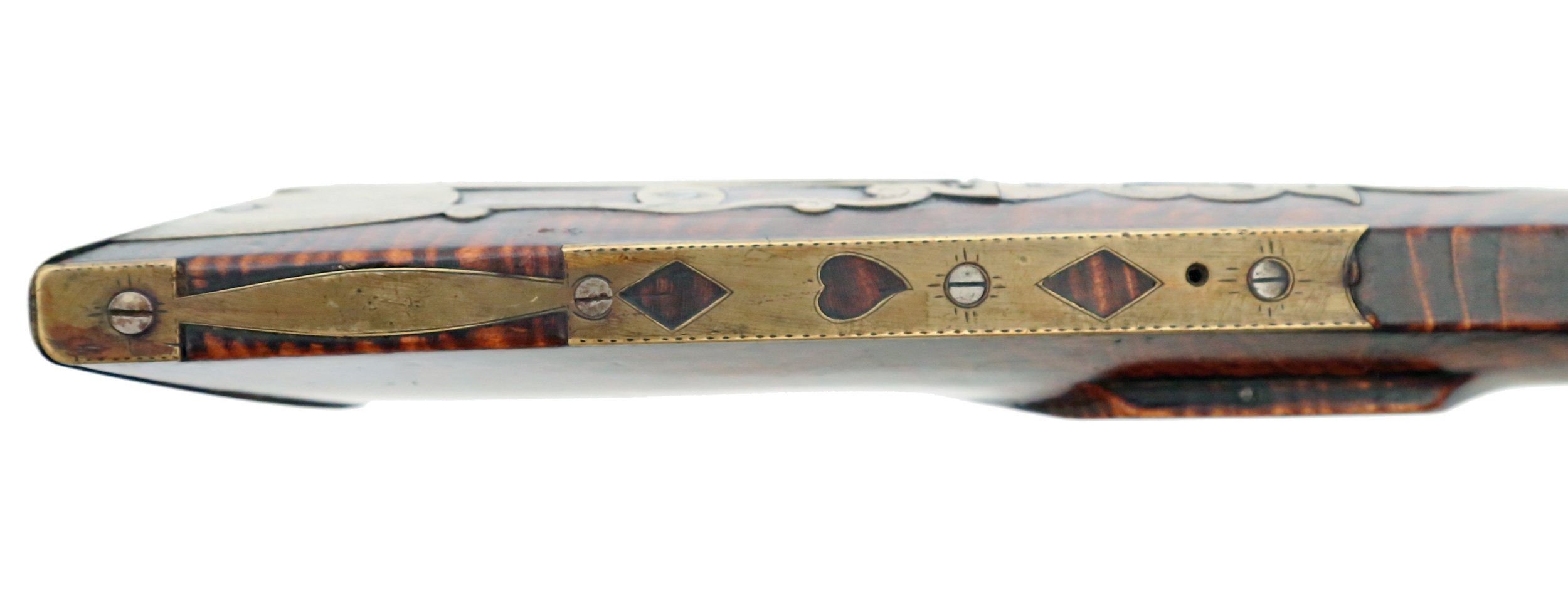A Bardstown “Ghost” Rifle by Henry Killen ©
Foreword: For years only one signed rifle by Kentucky gunsmith Henry Killen (1804-ca.1865) was known to collectors. Killen was apprenticed to Jacob Rizer in Bardstown, Nelson County, Kentucky, in May of 1818 and completed his training in 1825. He remained in Kentucky for about two years, then moved to Rutherford County, Tennessee, [below Nashville] in 1827 to work, marry, and raise a family. His only known rifle, a full-stock with attractive patchbox and silver inlay work, had a “Kirkman Nashville Tennessee” marked lock plate, indicating the gun was made after Killen’s arrival in Tennessee. Despite the superior quality of Killen’s work, no other Killen rifle has surfaced in the last 40 years, leaving questions about his early Kentucky work. It was as if his guns had vanished like ghosts. Then in 2019 a Killen “ghost” rifle finally appeared, and it was all that could be hoped for… an early Bardstown style rifle from his first years in Kentucky.
Figure No.1: The only known Killen rifle for many years is signed “H. T. Killen” on a silver barrel plate. The gunsmith’s full name was Henry Thompson Killen, and he worked in Kentucky, Tennessee, and Illinois. Author’s collection, photo by J. Jaeger.
Killen’s History: Henry T. Killen was born in 1804 in Hardin County, Kentucky, to parents Robert Killen and an unknown second wife. Robert came from Delaware, spent time in North Carolina and Tennessee, and arrived in Hardin County, Kentucky, in 1793 as a surveyor. His first wife Elizabeth died in 1797, and Robert remarried soon after. His second wife had four children between 1802 and 1806, with Henry T. Killen being the 3rd child, before she died due to childbirth difficulties with the 4th child in 1806. Robert married a third time to Sarah Hoback in 1808. But in 1816 tragedy struck again when Robert died, leaving a large family without a breadwinner. Following the customs of those days, Henry’s older brother William was apprenticed to a Nelson County blacksmith in 1817, and Henry was apprenticed to gunsmith Jacob Rizer in May of 1818, providing stability in the young men’s lives.
Killen completed his training in May of 1825. Limited information suggests he went back to Elizabethtown in Hardin County where family members lived, and where gunsmith David Weller opened a gun shop in 1826. Weller was Rizer’s partner during Killen’s apprenticeship days and may have influenced Killen’s decision to return to Hardin County. Killen’s later work used details from both Rizer’s and Weller’s guns, so Killen was well acquainted with both men. During his first years from 1825 to 1827 in Hardin County, Killen would have produced Bardstown style rifles… but those rifles have remained unknown for many years… invisible like ghosts. In 2019 a “ghost” rifle finally appeared.
In 1841 Killen left Tennessee and moved permanently to Clinton County, Illinois, where he was listed as a “gunsmith” in the 1850 and 1860 censuses. He died in Illinois sometime after 1860, but his actual date and burial location are unknown. Fate seemed to follow Killen to Illinois. No signed Illinois rifle by Killen has been reported, making his Illinois guns today’s “ghost” rifles.
Figure No.2: This fine “H. T. Killen” signed rifle was the only known work by Killen for many years. Its superior quality is evident in the elaborate patchbox and guard, coin silver inlays, and fine stocking. The gun retains its original flintlock plate, now converted to percussion, stamped “Kirkman Nashville Tennessee.” The hardware store stamp indicates the gun was made in Rutherford County, Tennessee, within a few years of Killen’s arrival in 1827. Barrel: 46 inches long with .34 caliber bore. Author’s collection, photo by J. Jaeger.
The First Killen Rifle: For many years the only known Killen rifle resided in the California collection of Larry Shelton, author of California Gunsmiths 1846-1900. The gun, pictured in Fig. No.2, was long and slender and made as a flintlock but later “percussed.” It had a fine, heavily engraved patchbox, exceptional pierced toe plate, and silver cheek and forestock inlays as seen in Figs. No.3 and No.4. A silver barrel inlay was signed in neat script, “H. T. Killen,” and is shown in prior Fig. No.1. The author eventually acquired the gun, only to discover the lock plate was marked “Kirkman Nashville Tennessee,” indicating the gun was made in Tennessee after Killen’s departure from Kentucky in 1827. But it was still the only signed Killen rifle known and had vestiges of Killen’s earlier Bardstown, Kentucky, training, so it was the “poster boy” for Killen’s work for many years and was illustrated in Kentucky Gunmakers 1775-1900. For a well-documented gunsmith who worked for many years, Killen’s work was virtually non-existent; his “missing” guns were often speculated about but remained “ghosts” to collectors until the appearance of a second rifle in 2019.
Figure No.3: Henry Killen made this rifle as a single bolt flintlock about 1830 in Tennessee, and it retains several Bardstown details. The extended vine pattern on the patchbox lid is a Bardstown detail, and the patchbox shows an interesting “twist” on the standard Bardstown finial. If the two large “S” curves are flipped so narrow at the base and wide at the top, it becomes a Bardstown finial. Author’s collection, photo by J. Jaeger.
Figure No.4: The back of the circa 1830 Killen rifle shows its fine curly maple wood and clean butt lines. The Bardstown star, usually in the cheekpiece, sits behind the cheekpiece. A small “step-down” in the side facing’s top edge on Bardstown guns is missing from Killen’s Tennessee work. A shield-shaped inlay atop the wrist and smaller shield inlays decorate the sides of the wrist. Author’s collection, photo by J. Jaeger.
The “Ghost” Rifle: In 2019 a Bardstown rifle came up for sale in a California auction. Its barrel signature was blurred, but the work was unmistakable… it was a Henry Killen rifle from his first years in Kentucky. The author had searched for a Kentucky-era Killen “ghost” rifle for years, saw the auction rifle, and purchased it. The rifle is shown in Fig. No.5 with its distinctive Bardstown patchbox and stock architecture. Smaller details on the gun are shown in Figs. No.6 and No.7. It has Rizer’s shield-shaped wrist inlay and engraved patterns on the patchbox, and Weller’s more deeply pierced patchbox finial. Both Killen rifles have long, elaborate, pierced toe plates; the Kentucky gun’s fancy toe plate is shown in Fig. No.8. Killen’s first years between 1825 and 1827 are poorly documented, but limited evidence suggests he was in Elizabethtown in Hardin County, Kentucky, where family members lived, and where he would have made Bardstown-style rifles. The long-lost Killen “ghost” rifle finally allowed his earliest work to be documented; as expected, it showed the details of a Bardstown-trained gunsmith working in Kentucky.
Figure No.5: In 2019 a Bardstown rifle by Henry Killen was found. It was similar in dimensions to his circa 1830 Tennessee rifle, but it had the traditional Bardstown patchbox. While not as heavily inlaid as the Tennessee gun, its forestock inlays share the same basic curved shape. Both rifles retain their original length barrels, but this gun had a patent breech installed when percussed. Killen’s barrels do not exhibit the heavily swamped muzzle and breech found on earlier Bardstown rifles. Barrel: 46 inches long with .40 caliber bore. Author’s collection, photo by J. Jaeger.
Figure No.6: Henry Killen’s Bardstown rifle has the “trademark” Bardstown patchbox with engraved vine growing out of the lid’s catch rivet. Killen was trained by Jacob Rizer, but the patchbox finial has Weller’s deeper piercing. Author’s collection, photo by J. Jaeger.
Figure No.7: The reverse of Killen’s Bardstown rifle has a tpical Bardstown butt plate with small step-down on the top extension. The cheekpiece retains a flat lower section, and the lock bolt washer seems to have a “stylized eagle” shape. Author’s collection, photo by J. Jaeger.
Figure No.8: Henry Killen used a long, elaborate toe plate on his rifles, a rare detail on Kentucky guns. His Bardstown rifle’s toe plate has heart and diamond piercings. The patchbox release button is hidden under the toe plate’s narrow rear section, similar to his other rifle’s release button.. Author’s collection, photo by J. Jaeger.
Summary: Rifles by Henry T. Killen are extremely rare with only two examples known, one from his brief Kentucky period in 1825-1827, and one from his early Tennessee days circa 1830. Both rifles exhibit superior quality with large patchboxes, fine engraving, and related silver inlay work. Strong similarities are seen in the two guns’ stock architecture, forestock inlays, barrel length, and engraved details, despite the later rifle showing Killen’s evolving style that was moving away from his earlier Bardstown training. The Tennessee gun has been known for many years, but it took another 40 years for a second Killen rifle to appear, an unexpected [but long anticipated] “ghost” rifle from his early years that documents his Bardstown training. Today, collectors are looking for a signed Killen rifle from his later Illinois years… but that “ghost” remains elusive and leaves collectors speculating again… perhaps for another 40 years.
Author’s Note: Additional images of the two Killen rifles and a more complete biography are available in Kentucky Gunmakers 1775-1900, Epilogue, available at www.kentuckygunmakers.com. The web site promotes Kentucky longrifles and Tansel powder horns.








